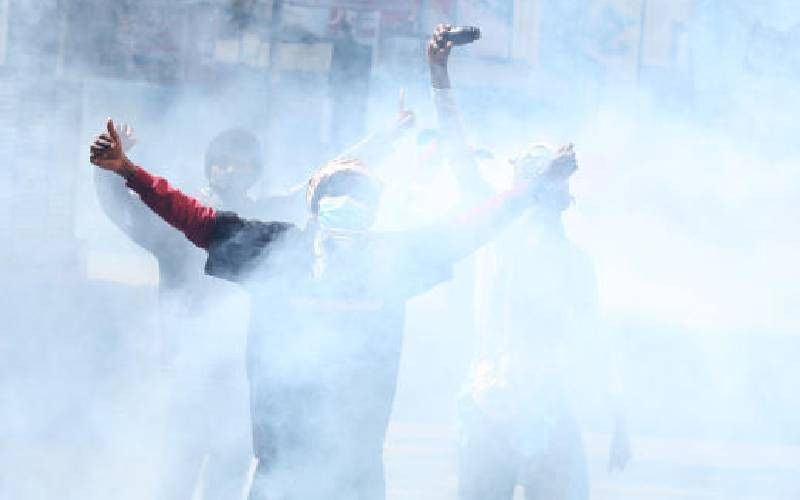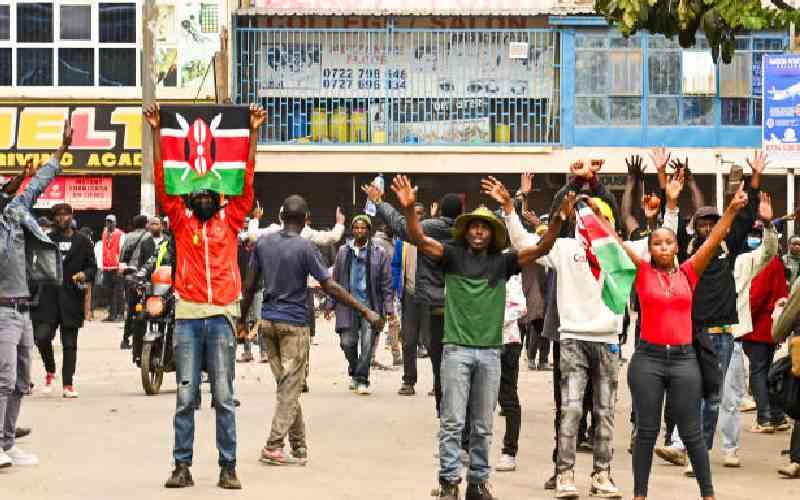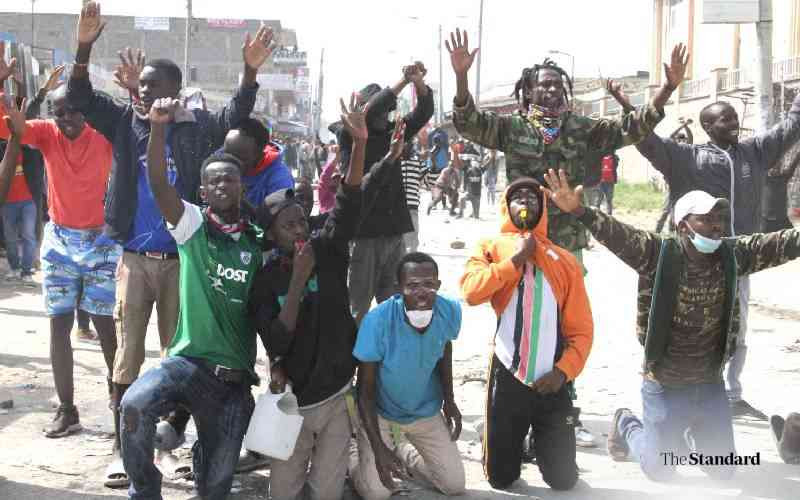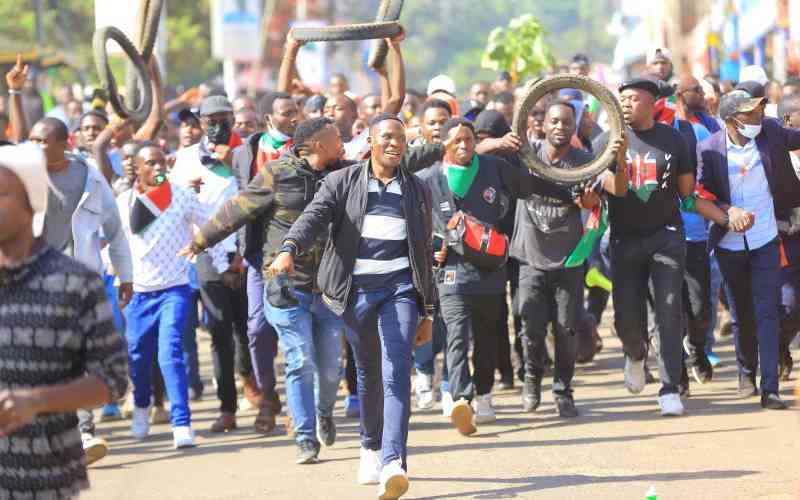
Anti-riot policed officers rough up one of the protesters during the June 25, 2025, demonstrations in Nairobi's CBD. [Jonah Onyango, Standard]
The vigorous return of Gen-Z activities in Kenya’s streets is loaded with ominous messages on unfinished business. It arrives with questions galore. The political class cannot possibly ward them off by whistling in the dark, and strawman fallacies. It must confront the shadows within.
However, rather than face the facts, the Executive is crying wolf. Interior Cabinet Secretary, Kipchumba Murkomen, has sensationally claimed that the Wednesday demos across the country were a failed attempt against President William Ruto’s government. The Executive, he says, has instructed the independent National Police Service to “shoot to kill” any suspected putschist. And Deputy President, Prof Kithure Kindiki, has vowed, “What happened on Wednesday will never happen again!” He concludes cryptically, “And don’t ask what we are going to do.”
The two senior state officers are at once scary and ominous. They are promising Kenya more abuse of civil liberties and arbitrary rule. Accordingly, expect violence and disappearances on a new scale. This time, however, there will be no doubt about the owner of the ruthlessness. Murkomen and Kindiki have said it is the state, “Don’t ask what we are going to do.”
The next few months are, accordingly, likely to see Kenya morph from authoritarianism to unbridled dictatorship. Unapologetic state-sponsored cold blood awaits Kenyans, according to CS Murkomen and DP Kindiki. The shooting, a few days ago, of Boniface Kariuki, an inoffensive mask vendor, has only heralded worse things to come. According to the Kenya National Commission on Human Rights (KNCHR), the police killed close to 20 more people during the Wednesday demos. The numbers could be higher.




Can the Kenyan state contain a dissatisfied citizenry through violence? Are razor wires, poisonous teargas, truncheons, goons and guns the solution to agitation by Kenyans for better governance? Can President Ruto secure his regime through unbridled violence and arbitrary killing? How far could that take the regime, without returning Kenya to the International Criminal Court (ICC) at The Hague? Does Murkomen’s “shoot to kill” order, and Prof Kindiki’s “Don’t ask us what we are going to do” mark them as potential felonies in office? Are they potential future subjects for human rights litigation at home and away? What is the possibility that they could slow down to face the facts on what ails the country and deal with them?
One thing is not in doubt. President Ruto’s government is riding a tiger. Kenya’s accumulated historical demons have returned to haunt the country. Abusive social and economic chickens over the past four presidencies are coming home to roost. It is doubtfully valid that anyone wants to overthrow President Ruto. Yet, as this writer has opined before, the national political leadership is sleeping through a revolution. The accrued groundswell of misrule has finally caught up with the political leadership. The Ruto government bears the brunt of getting it right, or getting damned. They seem to have chosen damnation over salvation. It matters not who committed the original sin. Ruto and Raila Odinga are in charge. They must shape up or ship out.
Shoot to kill order
Whatever name they give it, the civic wind of change in the country is unstoppable. History teaches us that social and economic dirt cannot be swept under the political rug forever. In the fullness of time, the dirt returns to eat up the system. President Ruto is a self-confessed enemy of history, an academic xenophobe of sorts. He reveres his own studies in botany and rubbishes the wider relevance of history in the education curriculum. Accordingly, he will be poorly placed to understand that the disaffection in his country is not just about him. It is about everything that has gone wrong since independence. Ruto is, however, the perfect poster boy, now on a roller-coaster to damnation, if he will not do the right thing.
READ: History shows Gen Z demos will continue to push for real change
June 25 was always coming, but the political class has equally wanted to wish it away. Those who came before Ruto got away with it. It is unlikely that he will be as lucky, all the threats and deaths notwithstanding. Shooting to kill does not seem to be the answer. Nor will shutting down radio and TV transmission save the Ruto regime, or even future ones. The political class needs to face the Project Kenya story squarely.
The TJRC Report of May 2013 gave Kenya 2,210 pages of what ails the country, and what can be done about it. The report, however, is gathering dust in Parliament, even as the situation deteriorates steadily. Is the day here, when the president and Parliament must address both historical injustices and failures, and emerging leadership betrayals and let-downs? If they are unable, or unwilling, they must prepare to be mauled by a tired and angry nation.
President Ruto, specifically, needs to ask himself whether he has not failed Kenyans. In his public bearing and messaging, Ruto comes across as a supercilious leader who believes himself to be all-knowing. His attitude and response to everything is that of dismissive fiat and condescension. “I am the President,” he says, “I have a PhD!”, “Nobody can stop me”, “I know what I am doing.”
There are no worldly-wise individuals in real life. Accordingly, President Ruto needs to take a deep look in the mirror, to tell the person he sees there, “You have failed the Kenyan nation. You arrived promising so much. You have delivered nothing. Indeed, you have messed up even the little that was. Now you are hiding behind razor wire barricades. You are running away from the electorate and terrorising the youth, because they are calling you to order.
Stay informed. Subscribe to our newsletter
Ruto arrived on a roller-coaster of promises and hope, most of which he has betrayed. He promised to end abductions and extra-judicial killings. These are now the order of the day. His Deputy and his Interior CS have promised the very worst of state fiat in the coming days. Ruto promised not to weaponise the criminal justice system, but everywhere today the Directorate of Criminal Investigations and the Ethics and Anti-Corruption Commission harass dissenters and independent voices. People are thrust into police cells on frivolous grounds, only for the matters to fizzle away.
The Hustler Fund which was supposed to kick-start and drive the bottom-up economic agenda, has all but died. The healthcare system has become at once an implementation nightmare and a tax burden. The affordable housing programme has become a pay slip furnace and a gravy train for shadowy persons. The digital economy promise has mutated into a conveyor belt of public resources into private pockets. The cost of living continues to skyrocket through multiple taxation. The promise to clear all public debts within the first two years of the Ruto regime has fallen flat on its face. Instead, both the foreign and domestic debt burden has grown astronomically.
Untamed greed
But borrowing and taxation are just a part of the problem. The real issue is greed. Greed is at the heart of the matter. Unrestrained desire for the good life at public expense, and wallowing in stolen wealth by opulent state officers, was one of the major issues that Kenyan youth protested against in June last year. There was an unashamed display of prosperity in the midst of unemployment, poverty, and the adversity that goes with the two. Schools and universities were meanwhile getting defunded, while education generally was in free fall, with the arrival of an illogical competence-based curriculum. Youth graduating from institutions of higher learning, at the same time, unable to find a place on the labour market.

President Ruto responded to the protests by laying out a slate of reforms that would be implemented instantly. There would be no more harambees by state officers, including himself, ministers and principal secretaries. The number of advisers would be cut down drastically, funding of offices of first ladies would cease at once. The war against greed, corruption and opulence was on, Kenyans believed. Yet, they were so wrong. All these were stopgap pronouncements that the president and his government went back on, as soon as Ruto entered the arrangement with ODM leader, Raila, to form a joint administration, called “the broad-based government.”
These are the things working up not just the youth but Kenyans of goodwill generally. The difference between the youth and the rest is the flow of adrenaline that drives the young into the streets. It is self-deluding to imagine that threats, intimidation and even actual killing could end public protests. As this writer states elsewhere in this paper, protests against misgovernance in the country have gone on for decades. Each regime deludes itself with the thought that clampdowns will arrest demos that eventually morph into riots. Hard tackles have not worked. They are unlikely to work. Nor will sidestepping of the main issues and creation and attacking of men of straws.
President Ruto is rudely learning that putting Raila in a cage will not take away his leadership nightmares. Raila does not have the monopoly of ventilating public frustrations. The demos went on, despite Raila’s absence, and his equivocation on the people’s right to demonstrate and to picket. Not even the ethnicization of the country’s challenges is working. The president has spent the past one year in incessant visits to Luo Nyanza in the false belief that if he bags the Luo, his problems will be over. There has been the misplaced imagination that it is the Luo who demonstrate. Kenyan youth have told you that they are tribeless. Kikuyu, Luo, Kalenjin, or others, they were all in the streets on Wednesday.
Kisumu and Kibra, two landscapes associated with the Luo, did not demonstrate this time. Yet Luo youth all over the country joined others in demos in at least 24 counties. The myth has been debunked that what Raila says his community will do. Like everyone else, they too think for themselves. But what happened in Kisumu and Kibra? Impeccable sources have it that the money dispensing machine mollified youth leaders who usually mobilize the rest.
The demos have suggested that the equivocating Raila has run his course. Even he seems to acknowledge this. While advising the youth on demos, he framed his street engagements as past habits that have been eaten up by time. “We used to hold peaceful demonstrations,” he said, in the manner of a wizened elder who has retired from the arena. His casting of his demos in the cask of a recurrent historical affair speaks of a leader who has done his Shakespearean ages on the political stage. He has been a mewling infant, a whining schoolboy, a sighing lover, a cursing soldier, and a wise judge with a fair round belly. He is now gladly at home in his slippers, as the youth run riot.The message from the Gen-Zs is that the demos will go on, with or without the mercurial Agwambo who, once long ago, ruled the streets.
Legitimacy
Where do these matters leave President Ruto? The message he is getting is that a critical mass of the adult population has rejected him. When a leader hides behind razor wire fences and menacing artillery, he needs to talk to his soul. Is he still legitimate? What is the wider relevance of his continued strife for office, both now and in the future? Should he struggle to get another term? What good will it serve, beyond the ego trip? And what will he do differently, so that the country gets out of the unending civil strife? Yet, rather obviously, there will be flatterers and sundry self-seekers, telling him how he is a godsend. They will help him to sidestep the issues, to believe that there are only a few people who hate him, out there, because of his tribe. That they are the ones sponsoring millions of youths to protest against their government. They tell him that such people should be crushed. Shoot to kill. In effect, however, they do not help him at all, except in digging further the deep hole in which they all are.
ALSO READ: Gen Z faces down threats in return to street marches
Together with the president, the present team may need to wonder whether they have not lost both dignity and legitimacy. How do you justify your legitimacy by pouring goons and guns into the streets? What will you do with another five years, if they are to be added to the remaining two? Will you expand the army of goons? Do you perhaps need to hold honest counsel with yourself, instead, and squarely face the truth?
And what is the truth? That Kenya Kwanza has failed. The regime is cringingly clutching onto straws. Another five years under the regime will only cast the country into total anarchy and state failure. That the president has no capacity to listen to the voices of reason. Anyone who thinks ever so slightly differently becomes an instant enemy, “to be shot to kill.” That the rest, they believe, they can buy. That they have trapped and caged ODM with sundry sweeteners.
But the strife continues, even on a wider scale. Even if they buy some more parties and individuals, the crises will not end until the underlying issues of corruption, cost of living, youth unemployment, cronyism, nepotism, negative ethnicity, authoritarianism, and above all, greed, are addressed. President Ruto does not seem to be the leader to face Kenya’s congenital challenges.
The message, however, goes beyond Ruto to future heads of the national Executive. They need to be warned. It is no longer the same country that earlier presidents ruled. Kenya has woken up. It is going through a revolution. The Mexican revolution took 10 years (1910-1920); the American Revolution 18 years (1765-1783); and the Russian Revolution gathered steam over several decades before the eruptions of 1905 and 1917. It is the same with the Kenyan revolution, now in motion. It will probably not explode in President Ruto’s face. Yet it is even more likely to erupt in the hands of the next president.
For, we are dealing not only with questions of yesterday, but the accumulated negligence of decades of misrule. Ruto is the only current custodian who has made things worse by accelerating the pace. He is the person currently holding the tail of this tiger. If he continues to listen to his ego and to the sycophants, the tiger will eat him. And provided that there is no reform, it will eat the next president, and the one after.
Dr Muluka is a strategic communications adviser and DNA secretary general